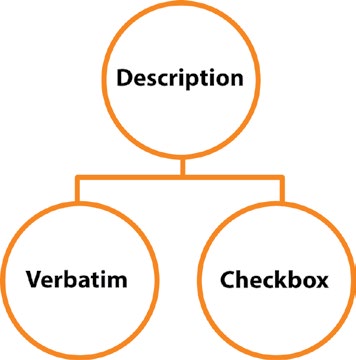3.5 Description Formats for Congenital Anomalies
‹View Table of Contents

Fig. 3.8. Description formats
On the abstraction form, information about congenital anomalies is ideally captured using either a verbatim description, or a checkbox, although sometimes both may be used (Fig. 3.8). From a quality standpoint, checkboxes alone are typically insufficient to achieve high data quality, both in initial data abstraction and in case review. However, if a country has the resources to collect data electronically, a checkbox could be useful as a first step, if there is a drop-down menu with more options to categorize the congenital anomaly. Nevertheless, having a field for verbatim descriptions allows details to be collected and the additional information may help clarify the diagnosis and classification, be used to plan the child’s health-care management, and help assess the accuracy and completeness of the information and coding during case review and ongoing quality assessment. Examples of verbatim and checkbox formats are presented in Fig. 3.9.
When coding the example case in Fig. 3.9, if the information available is limited to one of the checked boxes, the International Statistical Classification of Diseases and Related Health Problems, 10th revision (ICD-10) (12) code will be Q36.99 (cleft lip). However, if the verbatim description is available, the code will be more specific: Q36.9 (cleft lip, unilateral).
Table of Contents
- Chapter 3: Approaches to Surveillance
- 3.1 Population Coverage
- 3.2 Case Ascertainment
- 3.3 Case Finding
- 3.4 Case Inclusion
- ›3.5 Description Formats for Congenital Anomalies
- 3.6 Age of Inclusion
- 3.7 Inclusion of Pregnancy Outcomes
- 3.8 Coding System
- 3.9 Potential Inclusion/Exclusion Criteria
- 3.10 Core Ascertainment Variables
- 3.11 Data-Collection Methods and Tools
- 3.12 Data Management and Protocols
- 3.13 Data Collection and Management